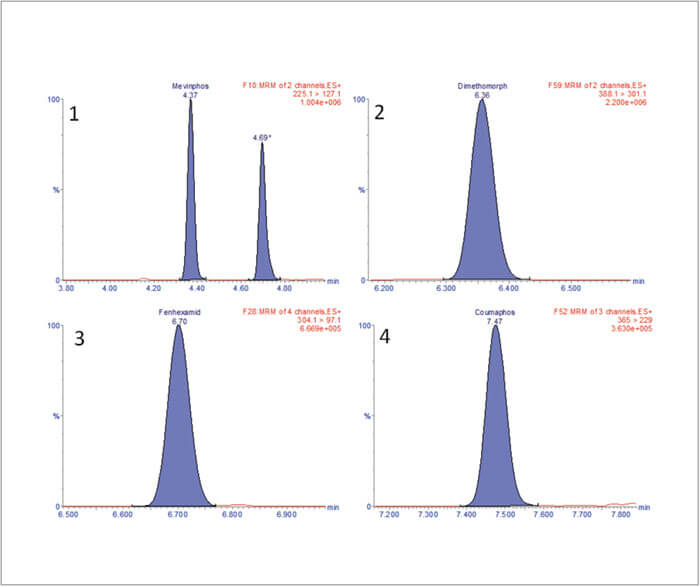A rapid workflow for screening the California list of pesticides and mycotoxins in a challenging cannabis matrix.
The aim of this study was to develop a sensitive and reproducible workflow for screening pesticides and mycotoxins simultaneously in cannabis using UPLCMS/ MS and GC-MS/MS to meet or exceed action levels set within the California regulations.
The objective was also to streamline the analysis using a simple sample extraction and dSPE cleanup which minimizes sample preparation, followed by automated method generation using Waters Quanpedia database.
Standard compounds for 66 pesticides and 5 mycotoxins were combined to produce a stock solution which was sequentially diluted to prepare the spiking solutions. Aliquots of 0.5 g of ground material were spiked with 0.10 μg/g (100 ppb) and 0.50 μg/g (500 ppb) of the acetonitrile spiking solutions. The mycotoxins were spiked at 0.02 μg/g (20 ppb) and 0.10 μg/g (100 ppb).
Both LC-MS/MS and GC-MS/MS were used as some residues are only amenable to either LC or GC. Tandem quadrupole MS is the detector of choice as it provides high sensitivity and selectivity for simultaneous analysis of hundreds of pesticides at low ng/g (ppb) levels in a single analysis.
Mycotoxins analysis by LC-MS/MS
The LC-MS/MS analysis of mycotoxins can be combined with the analysis of pesticide residues in a single analytical injection, allowing trace level detection of aflatoxins G2, G1, B2, B1, and ochratoxin A. The calibration curves for all mycotoxins were linear (R2>0.990) over the range tested 0.005 to 0.10 μg/g in matrix matched calibration curves

Pesticides analysis by LC-MS/MS & GC-MS/MS
The State of California monitors 66 target pesticides in cannabis. This list completely encompasses the Oregon pesticide list minus MGK-264. However, the California list has additional compounds like chlordane, captan (analyzed as its degradant THPI), and pentachloronitrobenzene (PCNB) which require GC-MS/MS due to poor ionization using electrospray ionization in LC-MS/ MS. There is a large subset of compounds that worked well using both techniques, therefore, analysis on both systems allows for increased confidence in results and the GC-MS/MS data can be used as an added confirmatory technique.
Recovery results between 80% and 120% demonstrated the high accuracy of the method, and the significant benefits of using dSPE to reduce matrix suppression.
This simple sample extraction and dSPE cleanup method followed by UPLC-MS/MS and GC-MS/MS analysis provides a rapid, sensitive, and robust workflow for determination of the California pesticide list and mycotoxins in challenging cannabis matrix.





